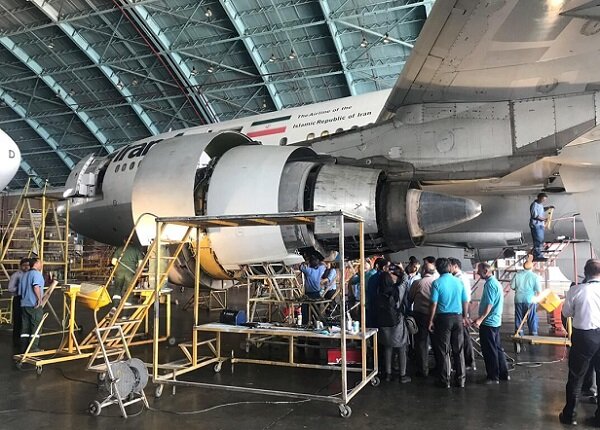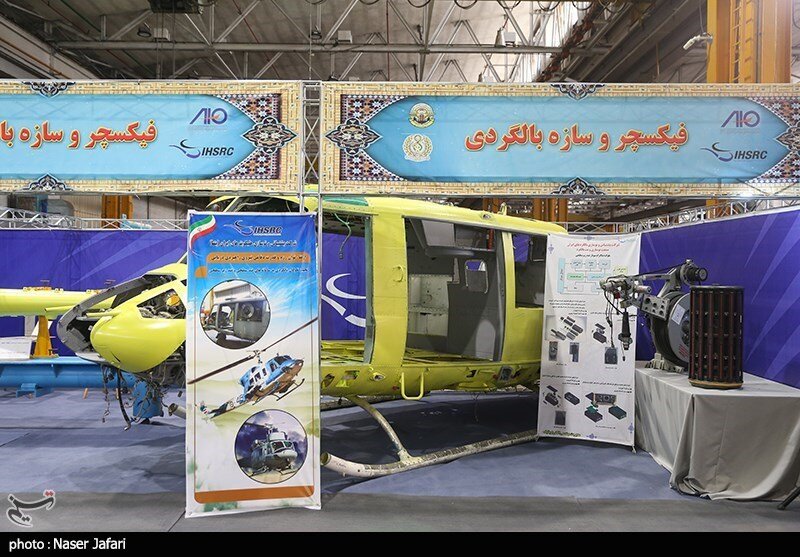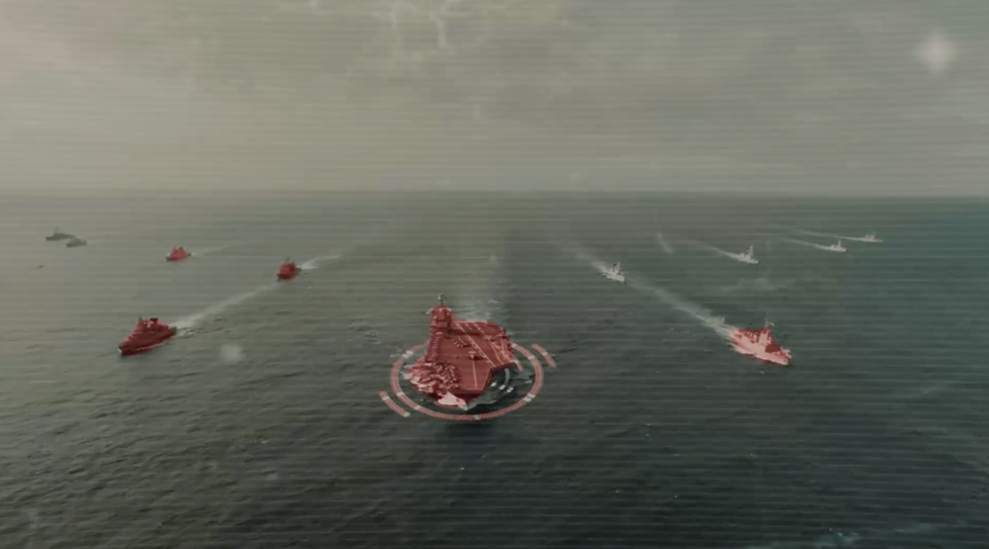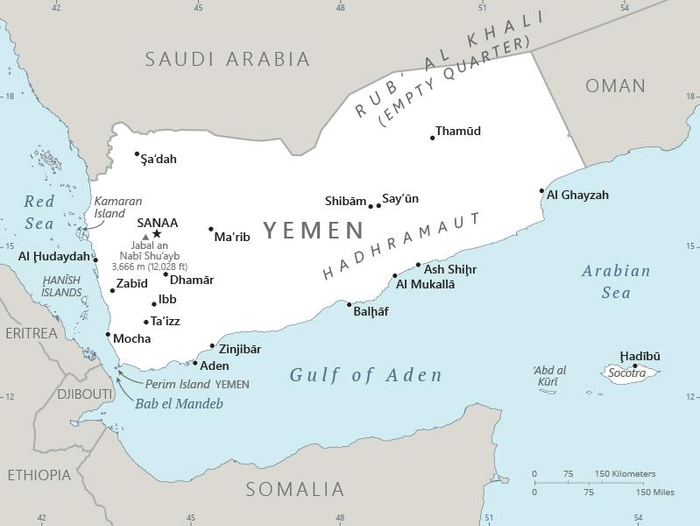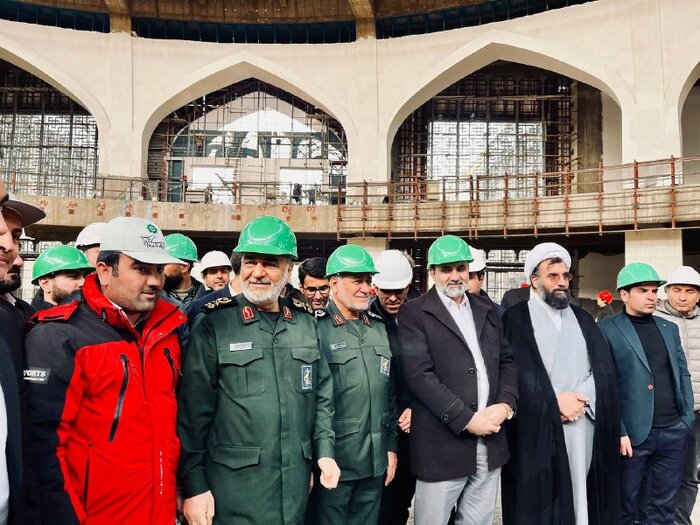
IRGC Commander-in-Chief Hossein Salami and Commander of the Khatam al-Anbiya Construction Headquarters Brigadier General Abdolreza Abed touring preparations for the Grand Mosalla Mosque of Tehran, IRNA (State Media) in March 2024.
“The enemy wanted to prove that ‘we can’t,’ and we had to prove that ‘we can,’ therefore, we were able to overcome the sanctions policy with the power of Khatam al-Anbiya Construction Headquarters.”
Iran claims it has been able to circumvent sanctions thanks to an infrastructure entity blacklisted by the United States: the Khatam al-Anbiya Construction Company (KAA). In an address published by state-aligned outlet Moniban News, Islamic Revolutionary Guard Corps (IRGC) Commander Hossein Salami cheered: “The enemy wanted to prove that ‘we can’t,’ and we had to prove that ‘we can,’ therefore, we were able to overcome the sanctions policy with the power of Khatam al-Anbiya Construction Headquarters.”
Established during the Iran-Iraq War (1980-1988), KAA functions as the IRGC’s lead contractor for civilian construction projects as well as its nuclear and ballistic missile projects. This resulted in its blacklist designation by the U.S. Department of the Treasury in 2010, given that its subsidiaries are known to funnel money to the IRGC and are used to fund its activities at home and abroad.[i] In the first excerpted article Salami noted that the KAA has helped the country be more independent and is a “powerful response” to sanctions playing a role in at least thirty sectors, including road and urban development, energy, marine, and oil sectors, and hospital construction. The KAA is considered one of the three main pillars of the IRGC-run economy. (The others are the Basij Cooperative Foundation and IRGC Cooperative Foundation.) Beyond its ability to help Iran circumvent sanctions, KAA has played an important role related to educational and employment opportunities. As per the second excerpted article from the Iranian state-run Entekhab News, Salami also emphasized that KAA has provided opportunities for university students not just in the field of engineering but all higher degrees. Additionally, it has prevented brain drain, a historic problem for Iran that has only increased in recent years due to the dire state of the Iranian economy due to U.S. sanctions and systemic mismanagement and corruption. While Iranian officials tend to fluctuate on whether U.S. sanctions on the country have impacted the economy, the recent comments by the IRGC Commander about the KAA seem to confirm that the punitive measures are not putting the necessary strain on the clerical establishment to change its behavior in the region.
Sources:
“سردار سلامی: بدلیل قدرت قرارگاه سازندگی خاتم الانبیا (ص) از تحریم عبور کردیم (General Salami: Due to the strength of Khatam al-Anbiya Construction Headquarters, we overcame sanctions),” Moniban News (State-aligned news. outlet), 3 March 2024.
Major General Salami added: One of the biggest things the construction headquarters did was refuting the enemy’s particular thinking in this regard. The enemy wanted to prove that ‘we can’t’, and we had to prove that ‘we can,’ therefore, we were able to overcome the sanctions policy with the power of Khatam al-Anbiya Construction Headquarters and jihadist bodies like the headquarters.
In explaining the hostile sanctions of Iran’s enemies, the IRGC commander stated: The sanctions policy was not a subjective and unrealistic policy, but rather an operational policy of the enemy, and it was completely objective, real, and tangible. But Islamic Iran, with the jihadist forces of Khatam al-Anbiya, was able to surpass and defeat the enemies of the Iranian nation.
In explaining the ethos of the Khatam al-Anbiya Construction Headquarters, he said: The ethos of the Khatam headquarters is not just providing technical work, but rather this headquarters is the heart of the revolution and its ethos is to preserve the political independence of the country, to restore the national self-confidence, and actually making the country not rely on the presence of foreigners, and follows this policy text in its basic actions, and for this reason, it undertakes great works and accepts risks…
Today, the Khatam al-Anbiya Construction Headquarters is playing a role in at least thirty various sectors: road and urban development, energy, marine, oil, hospital construction and unique buildings, and the subway.
The commander-in-chief of the IRGC states: The Khatam al-Anbiya Construction Headquarters has expanded in various specialized fields, which is a powerful response to the enemy’s sanctions.
“فرمانده کل سپاه: قرارگاه خاتمالانبیا جلوی فرار مغزها را گرفت (IRGC Commander-in-chief: Khatam al-Anbiya Headquarters prevented the minds from escaping),” Entekhab News (state-run media), 3 March 2023.
General Salami emphasized that the Khatam al-Anbiya Construction Headquarters has prevented elite minds from leaving the country. He said: The Khatam headquarters has provided a wide and modern field for technical and industrial elites of our country, and every engineer and doctor with any degree of education can fulfill their dreams during their time at university at the Khatam al-Anbiya Construction Headquarters.
Notes:
[i] The Khatam al-Anbiya Construction Headquarters was designated in 2010 by the U.S. Department of the Treasury. See: “Treasury Targets Iran’s Islamic Revolutionary Guard Corps,” U.S. Department of the Treasury, 10 February 2010. https://home.treasury.gov/news/press-releases/tg539
Image Information:
Image: IRGC Commander-in-Chief Hossein Salami and Commander of the Khatam al-Anbiya Construction Headquarters Brigadier General Abdolreza Abed touring preparations for the Grand Mosalla Mosque of Tehran, IRNA (State Media) in March 2024.
Source: https://www.irna.ir/news/85406994/%D8%B3%D8%B1%D8%AF%D8%A7%D8%B1-%D8%B3%D9%84%D8%A7%D9%85%DB%8C-%D8%AF%D8%B4%D9%85%D9%86-%D9%85%DB%8C-%D8%AE%D9%88%D8%A7%D9%87%D8%AF-%D9%85%D9%84%D8%AA-%D8%A7%DB%8C%D8%B1%D8%A7%D9%86-%D8%B1%D8%A7-%D8%AF%D8%B1-%D8%AD%D9%88%D8%B2%D9%87-%D8%B3%DB%8C%D8%A7%D8%B3%DB%8C-%D8%AE%D8%A7%D9%86%D9%87-%D9%86%D8%B4%DB%8C%D9%86
Attribution: CCA-SA 4.0 Intl.


